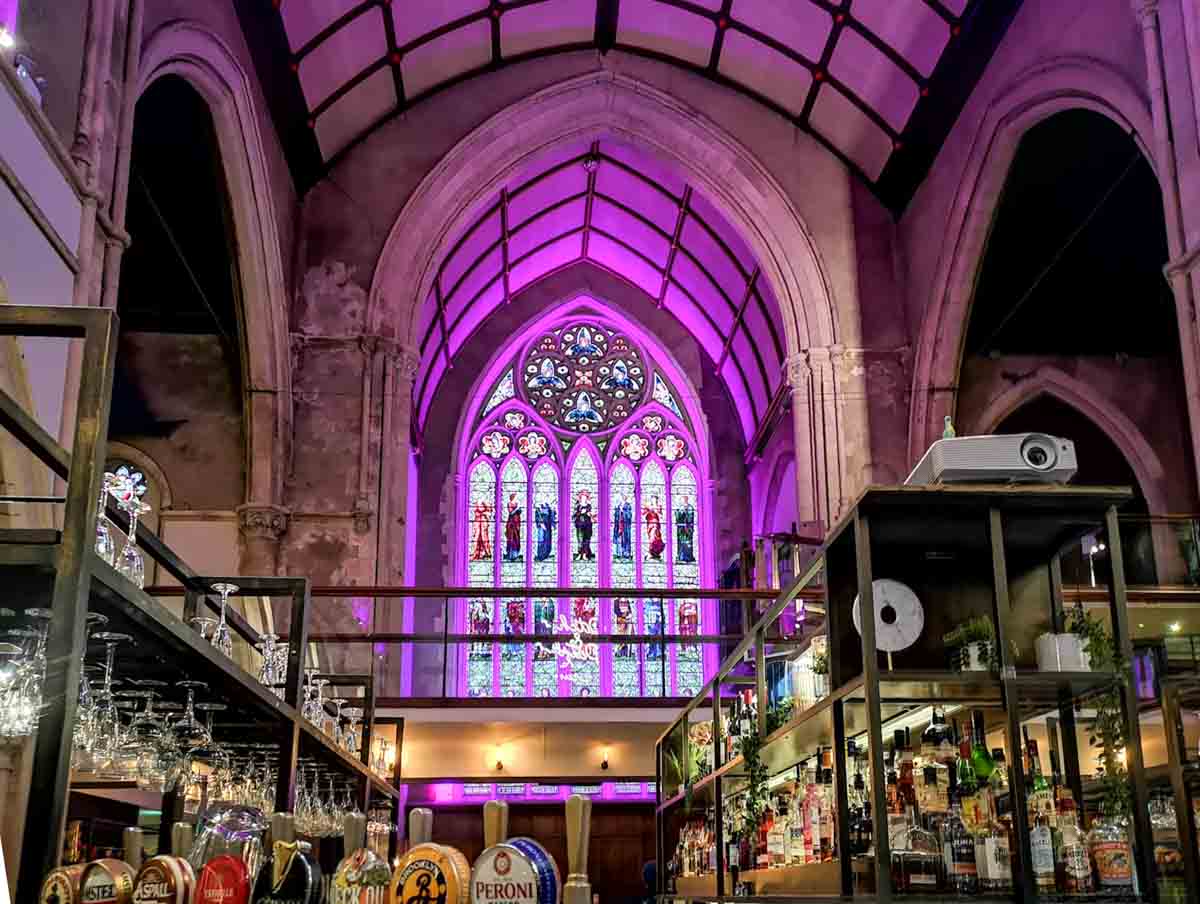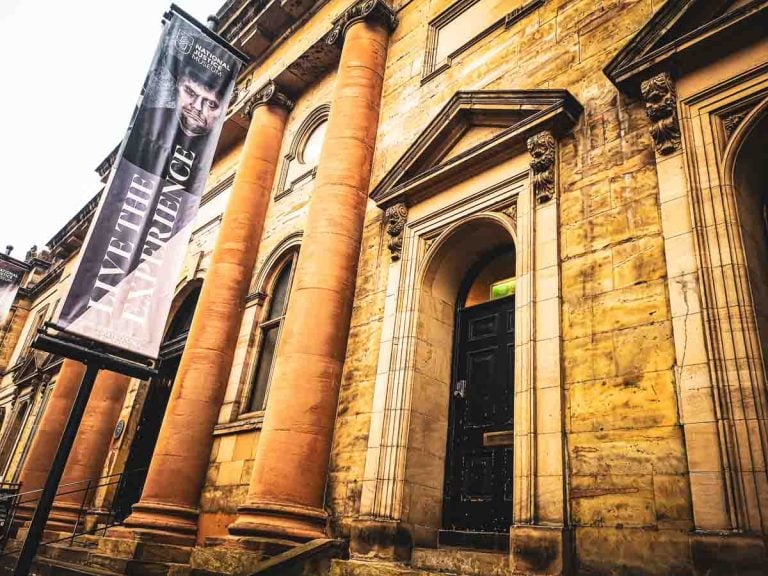The Lowdown
What is it?: A spectacular bar and restaurant set inside a converted Grade II listed Victorian Gothic church.
Cuisine: Modern British and European pub classics, from small sharing plates to hearty mains and brunch.
Vibe: Grand, atmospheric, and unique. Lively and buzzing in the evenings, perfect for dates or groups.
Price: Mid-range (££), offering good value for the unique setting.
Don’t Miss: The creative cocktails (especially during the 2-for-1 weekday offer) and taking in the magnificent stained-glass windows.
Location: The Unitarian Church, High Pavement, Lace Market, Nottingham, NG1 1HN.
First Sight: From High Pavement to Hallowed Hall
Wandering down High Pavement in Nottingham’s historic Lace Market, I saw it. Standing proud on a corner, its stone spire reaching for the sky, was a building that stopped me in my tracks.
It was, unequivocally, a church. A magnificent, Grade II listed, ornate Victorian Gothic church, to be precise, built in 1876 and looking every bit the part.
It had the gravitas, the soaring lines, and the air of solemnity you’d expect from a historic place of worship. One recent visitor aptly noted that from the outside, it “looks like any other church towering over the city’s skyline”.
But something was different. Affixed to its historic stonework was a sign that created a wonderful, jarring moment of cognitive dissonance. It read: “Pitcher & Piano.”
This is the moment of discovery, the hook that makes this place so compelling before you even step inside. The juxtaposition of the sacred and the social, the historic and the hospitable, is announced right there on the street.
For a national chain like Pitcher & Piano, securing such a landmark is a masterstroke. The building itself becomes the primary marketing tool, an architectural billboard that generates more curiosity and organic buzz than any conventional advertising campaign ever could.
Its grandeur and the sheer novelty of its function create an immediate desire to see what lies within. This isn’t just another pub; it’s an event, a destination.
It’s this unique identity that allows it to stand shoulder-to-shoulder with Nottingham’s most historic pubs, including Britain’s oldest, Ye Olde Trip to Jerusalem.
As I approached, the transition from sacred space to social hub became clearer. A pretty flower arch framed the entrance, and tables were dotted around an outdoor seating area, already buzzing with conversation on this mild evening.
It was a welcoming sight, skilfully bridging the gap between the building’s imposing history and its modern, relaxed purpose.
I stepped through the arched doorway, ready to see if the promise of the exterior could possibly be matched by the experience within.
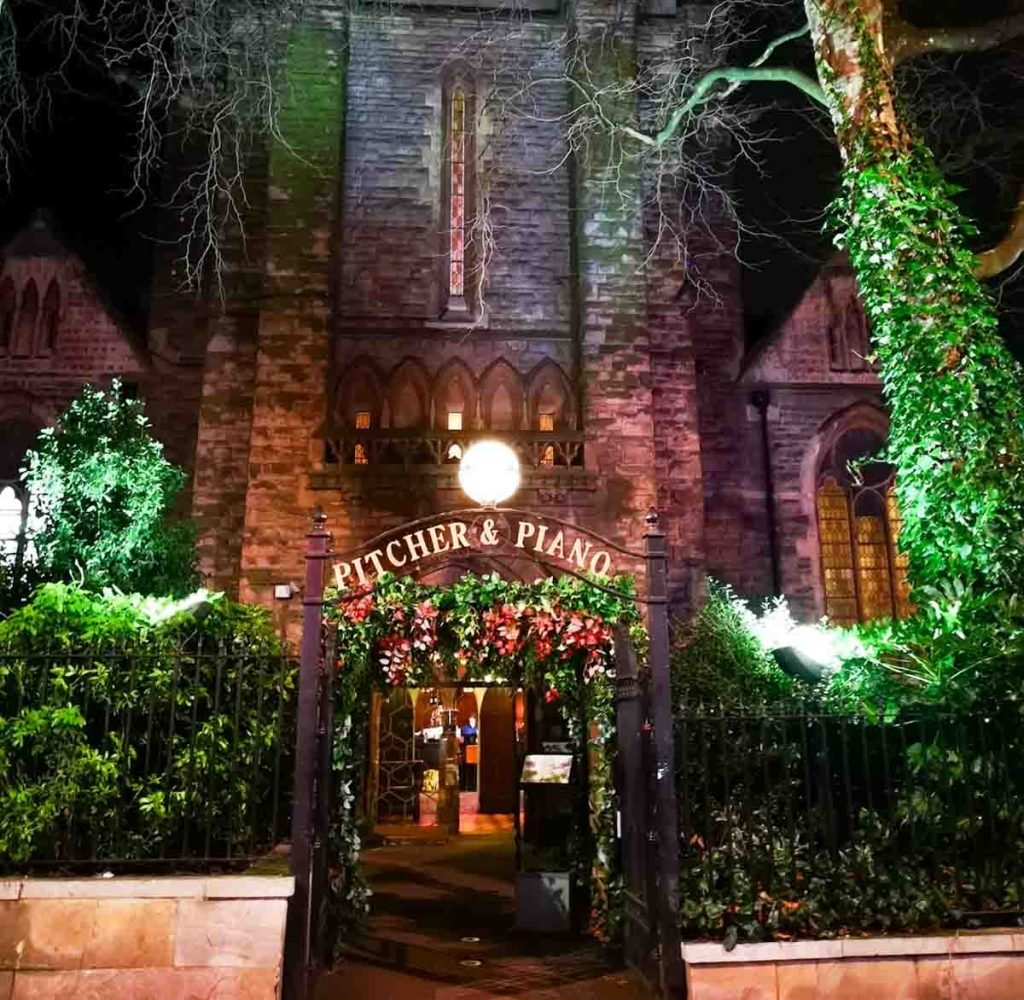
Inside the Sanctuary: Where Pews Meet Pints
The feeling upon entering is one of sheer awe. You step out of the bustling street and into a vast, cathedral-like space that commands a moment of silence.
Your eyes are immediately drawn upwards, past stone arches to a high, vaulted ceiling, and then back down to the heart of the room.
There, directly beneath a spectacular stained-glass window, sits a huge, centrally located island bar, glowing with bottles and polished brass—a modern altar dedicated to a different kind of spirit.
The interior is a masterful blend of “old and new,” a dialogue between the building’s past and its present.
Original features are everywhere, celebrated rather than hidden. You’ll find yourself sitting in reclaimed church pews, their dark wood polished by generations of worshippers, now repurposed for diners and drinkers.
The sheer scale of the main hall, once a potential challenge for creating a cosy pub atmosphere, has been brilliantly managed.
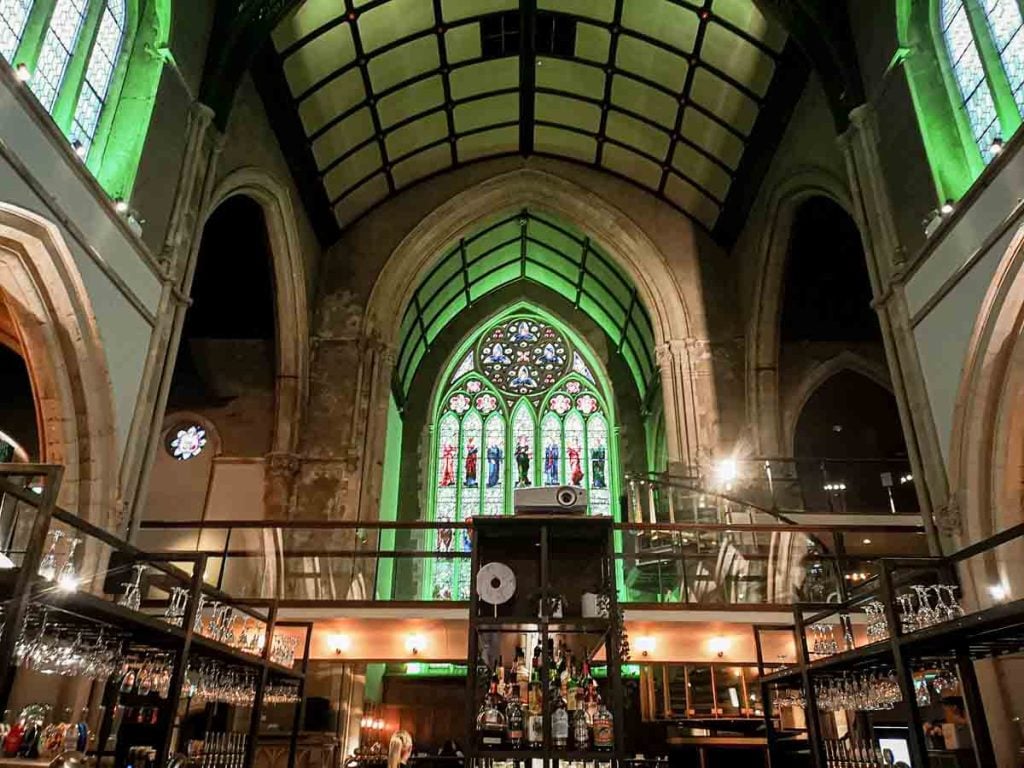
The designers have created a space that feels both grand and intimate, a unique atmosphere that one reviewer of a similar venue perfectly described as blurring the line between “ever-so cosy and ever-so creepy”.
This clever use of space is one of the venue’s greatest triumphs. A church’s traditional layout—a single, large nave—is not naturally suited to the varied needs of a modern hospitality venue.
Here, however, the space has been ingeniously segmented to cater to a multitude of experiences simultaneously. As I explored, I saw a mezzanine balcony level ringing the upper floor, offering breathtaking 360-degree views of the entire venue and serving as a perfect perch for people-watching.
This upper level can be hired for large parties, with some sections set up for formal sit-down meals and others for more casual buffet-style events with a private bar.
Back on the ground floor, tucked away in a recess, is the semi-private “Altar” area, an intimate space perfect for smaller gatherings, sitting directly under the magnificent east window.
Towards the back, a modern, glass-walled “Terrace Bar” offers a complete contrast—a bright, airy, and air-conditioned space with its own bar and an adjoining section of the garden, ideal for everything from corporate meetings to summer socials.
This intelligent design allows a hen party on the mezzanine, a couple on a date near the altar, and a business presentation on the terrace to coexist without disruption, maximising the building’s commercial potential.
The venue had fully transformed from a bright day spot into a “dynamic bar,” with the lights dimmed and the music turned up, creating an electric, evening atmosphere.
The hall was buzzing with a wonderfully diverse crowd—couples sharing a bottle of wine, and large groups of friends celebrating birthdays and starting their night out.
The playful spirit of the conversion is evident in witty little touches, my favourite being a former confessional booth that has been cheekily repurposed into a photo booth.
It’s this seamless fusion of reverence and revelry that makes the Pitcher & Piano in Nottingham a truly unique and unforgettable space.
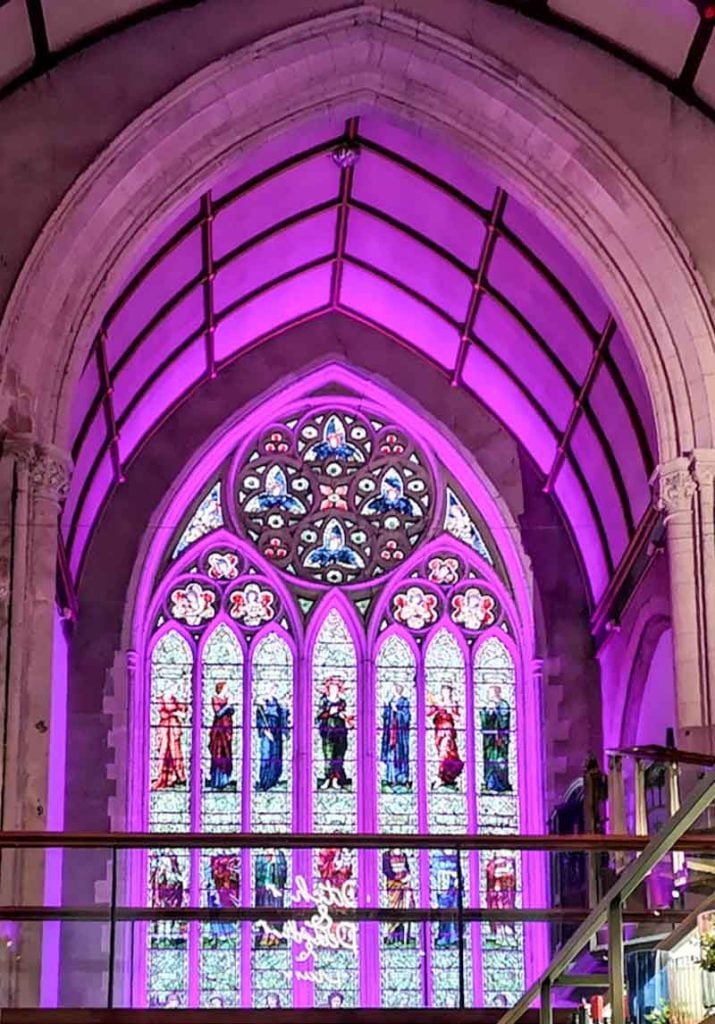
Whispers from the Walls: The Story of the High Pavement Chapel
To truly appreciate this place, you have to understand that you are not just sitting in a pub; you are dining amidst layers of profound social and political history.
The story of this building is the story of dissent, reform, and the very shaping of modern Nottingham.
Its origins lie in the tumultuous 17th century, specifically the “Great Expulsion” that followed the Act of Uniformity of 1662.
This act demanded that all ministers conform to the Church of England’s prayer book. In Nottingham, three Presbyterian ministers—John Whitlock and William Reynolds of St Mary’s Church, and John Barret of St Peter’s—refused.
Forced from their pulpits and then, by the draconian Five Mile Act of 1665, forbidden from even coming within five miles of the town, these men became fugitives for their faith.
They continued to preach in secret, holding clandestine meetings in houses and remote locations, laying the foundations for what would become the High Pavement congregation.
When the Toleration Act of 1689 finally granted them the freedom to worship openly, a permanent chapel was quickly established here on High Pavement, becoming one of the first registered dissenting chapels in the city.
Over the next two centuries, the chapel, which evolved to embrace Unitarianism, became a powerhouse of influence in Nottingham.
Its congregation was a roll call of the city’s elite: wealthy industrialists, especially the lace manufacturers who were building their fortunes in the surrounding warehouses, and radical thinkers who would drive social change.
Between 1775 and 1800, twelve of the town’s fifteen mayors worshipped here, making it a centre of immense political power.
Its ministers were often national figures, like the Revd. George Walker, a renowned orator whose reform speeches led the 3rd Duke of Portland to compare him to Cicero, and Peter William Clayden, a prominent journalist for the Daily News (a paper started by Charles Dickens) and a fierce anti-slavery advocate.
This congregation didn’t just preach progressive values; they acted on them.
In 1788, they founded one of the very first non-sectarian charity schools in the country, dedicated to educating the children of the poor regardless of their faith.
In 1807, they established the Provident Friendly Society, a pioneering mutual insurance scheme that provided a safety net for its members over a century before the introduction of National Insurance.
The building’s entire life cycle serves as a perfect microcosm of Nottingham’s own history.
It was built in its current grand form in 1876, funded by the wealth of the lace industry at its absolute peak.
As that industry declined, the congregation eventually moved in 1982 to a more modest, converted lace warehouse nearby, where they still worship today.
The chapel’s first post-religious incarnation was as the Nottingham Lace Museum, a poignant attempt to memorialize the very industry that had financed its construction—a venture that proved financially unviable.
Its final, successful transformation into the Pitcher & Piano in 1998 perfectly mirrors the Lace Market’s own regeneration into a modern district based on leisure, creativity, and hospitality.
Every stage of this building’s life reflects the economic and social tides of the city it serves.
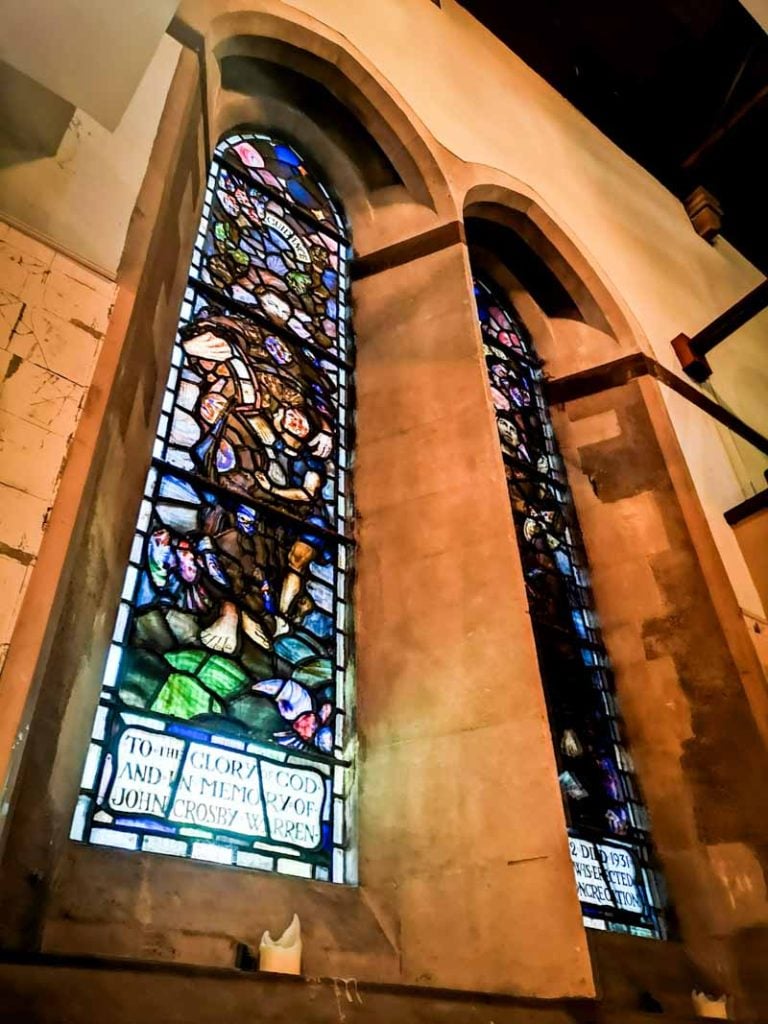
Art in the Aisles: A Closer Look at the Stained-Glass Masterpieces
While the architecture is breathtaking, the true artistic treasures of this building are its magnificent stained-glass windows.
These are not mere decorations; they are museum-quality works of art by some of the most important designers of the Victorian era.
The commercialisation of the building has had a wonderful, unintended consequence: it has turned this bar into an informal, accessible art gallery.
These masterpieces are now seen by a far wider and more diverse audience of casual drinkers and diners than they ever were when it was a chapel or a short-lived, specialist museum.
The undisputed “gem” is the glorious east window, which glows above the main bar.
This stunning piece was designed by Edward Burne-Jones, a leading figure in the Pre-Raphaelite movement, and created by the world-renowned Morris & Co., the firm founded by the visionary artist and designer William Morris.
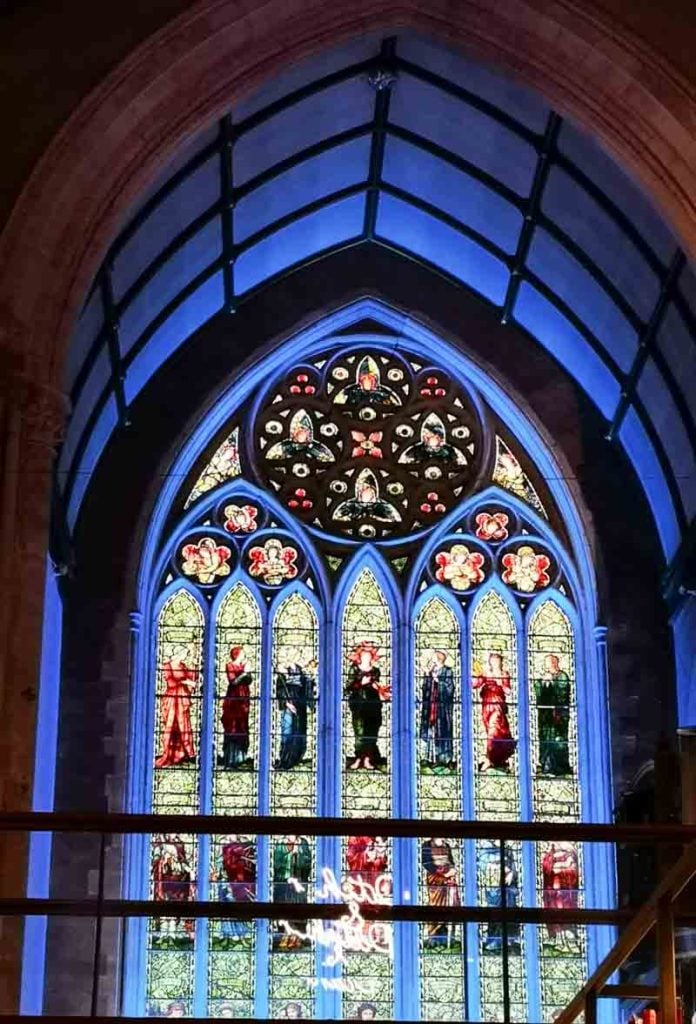
It was installed in 1904 as a memorial to the aforementioned minister, Peter William Clayden.
The window is deeply symbolic, a visual sermon in glass representing the virtues and aspirations of a progressive Christian faith. Its panels depict allegorical figures of Science, Literature, Theology, Philanthropy, Art, Philosophy, and Labour, a testament to the congregation’s belief in intellectual and social enlightenment.
But the beauty doesn’t stop there. Take a moment to find the north aisle war memorial window, a poignant piece created in 1925 by Kempe & Co.. It commemorates two cousins from the congregation, Roby Myddleton Gotch and Philip Joseph Crook, who were killed in the First World War.
The window depicts the figures of St. George and Sir Galahad, powerful symbols of the fight against evil and the chivalric bravery of the fallen soldiers. Elsewhere, you can find a Sunday School memorial window from 1906 designed by another significant artist, Henry Holiday.
To sit with a drink in hand as the evening light glows through these intricate, jewel-toned panes of glass is an experience that elevates the simple act of going to a pub into something truly special.
The internal lights illuminate scenes of saints and scholars, casting coloured patterns across the tables. It’s a moment of unexpected beauty and tranquility, a quiet connection to the art and history that permeates every inch of this remarkable space.
The Offering: A Review of the Food and Libations
A venue this spectacular sets high expectations for its food and drink. The Pitcher & Piano meets this challenge with a smart, crowd-pleasing “all-day” menu designed to take you from “morning coffee to midnight cocktails”.
The culinary strategy here is not to be a niche, fine-dining destination, but to provide a reliable and enjoyable accompaniment to the main event—the atmosphere.
The menu is broad, familiar, and highly adaptable, with something for everyone, from brunch and lunch deals to sharer plates and hearty mains, including a good range of vegetarian and vegan options.
It’s a clever approach that ensures the diverse crowds attracted by the building—from families to hen parties—all find something to enjoy.
Given the bar’s name and reputation, it felt right to start with the cocktails. The list is extensive, with classics sitting alongside creative “Gin Twists” and signature house creations.
I opted for a “Kiss From a Rose,” a sophisticated mix of Roku gin, Lanique Spirit of Rose, and tonic, garnished with rose petals. It was as beautiful as it was delicious—aromatic and refreshing, a perfect fit for the elegant surroundings.
The bar is famous for its offers, and the 2-for-1 deal on classic cocktails, running from noon until 7 pm on weekdays, is an undeniable draw.
For food, we embraced a tapas-style approach, ordering a few dishes to share. This style of eating feels perfectly suited to the relaxed, social vibe of the place.
We chose the Buttermilk Chicken, a plate of crispy tenders served with a rich garlic aioli; the Halloumi Fries, chunky, salty, and satisfying with a sweet chilli jam; and a Chicken, Bacon, and Red Onion Flatbread.
The food arrived promptly, ordered with remarkable ease via a QR code on the table—a modern touch that felt slightly surreal beneath the 150-year-old vaulted ceiling.
The verdict? The food was genuinely tasty, flavourful, and came in generous portions that kept us satisfied for hours.
The chicken was crisp and juicy, the halloumi had that perfect squeak, and the flatbread was the star—light and flavourful.
As one visitor rightly pointed out, you are paying a slight premium for the novelty of the location, but the quality is solid and the experience is more than worth it. It’s satisfying, well-executed pub fare that perfectly complements the stunning backdrop.
Final Verdict & Visitor’s Guide
The Pitcher & Piano in Nottingham is an absolute triumph. It’s a place where history, art, and hospitality converge to create an experience that is utterly unique.
While it is part of a chain, this particular venue feels entirely bespoke, a one-of-a-kind destination that has been thoughtfully and respectfully integrated into one of Nottingham’s most significant historic buildings.
The main draw is, without question, the astounding setting. Dining and drinking beneath soaring Gothic arches and magnificent Burne-Jones stained-glass windows is a novelty that simply does not wear off.
It’s an “excellent date spot,” perfect for an evening of cocktails under the atmospheric lighting, but it’s equally well-suited for a lively bottomless brunch with friends or as a memorable stop for any visitor to the city.
It succeeds in being many things to many people, a testament to its clever design and broad appeal. It is, without a doubt, a must-visit.
Practical Information
- Location: The Unitarian Church, High Pavement, Lace Market, Nottingham, NG1 1HN.
- Opening Hours: Open from late morning daily, with later closing times of 1 am or 2 am on Thursdays, Fridays, and Saturdays.
- Best For: Cocktails, Bottomless Brunch, Atmosphere, History & Art Lovers.
While You’re in the Lace Market…
The Pitcher & Piano is the perfect anchor for a day spent exploring the rich history of the Lace Market.
Its central location makes it an ideal spot to start with brunch, break for lunch, or finish with dinner after a day of discovery. Here are a few unmissable attractions just a stone’s throw away.
|
Nearby Attraction |
What It Offers |
A Perfect Follow-Up To… |
|---|---|---|
|
A former courthouse and gaol with immersive exhibits on crime and punishment, located in the historic Shire Hall. |
A sobering dose of history after some heavenly cocktails. | |
|
A hidden network of ancient man-made sandstone caves beneath the city, revealing centuries of history. |
An underground adventure to walk off a hearty lunch. | |
|
Nottingham Contemporary |
A striking modern art gallery with rotating international exhibitions, plus a stylish café. |
A splash of modern culture to contrast the historic venue. |
|
St. Mary’s Church |
Nottingham’s largest and oldest medieval building, a stunning example of Perpendicular architecture just down the street. |
A moment of quiet reflection and architectural comparison. |

